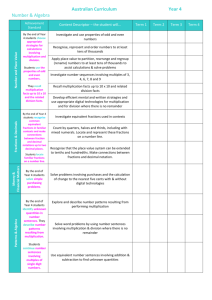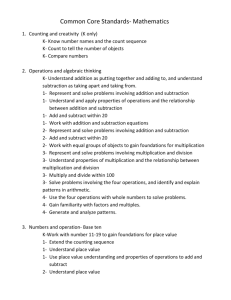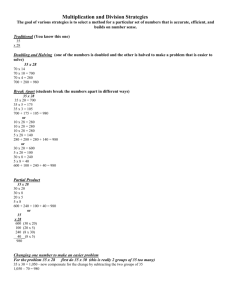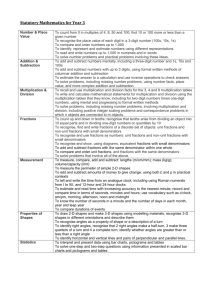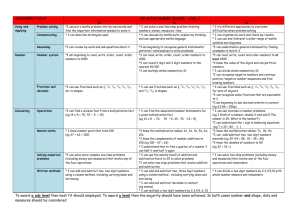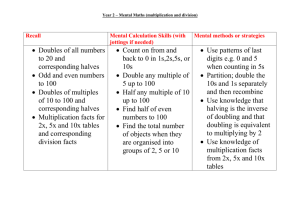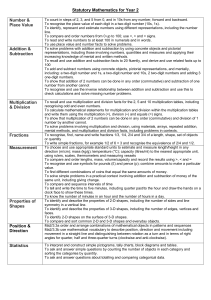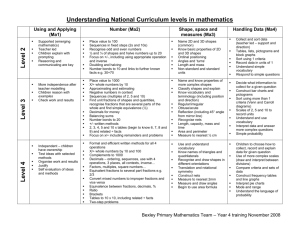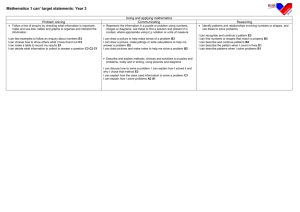Essential Learning
advertisement
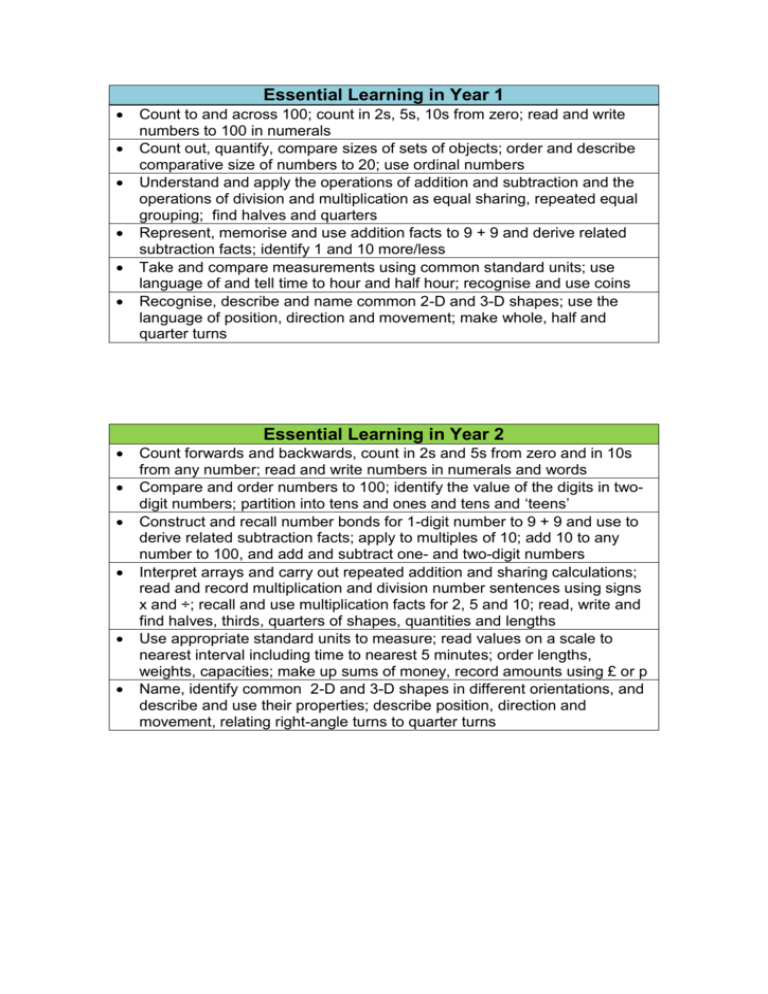
Essential Learning in Year 1 Count to and across 100; count in 2s, 5s, 10s from zero; read and write numbers to 100 in numerals Count out, quantify, compare sizes of sets of objects; order and describe comparative size of numbers to 20; use ordinal numbers Understand and apply the operations of addition and subtraction and the operations of division and multiplication as equal sharing, repeated equal grouping; find halves and quarters Represent, memorise and use addition facts to 9 + 9 and derive related subtraction facts; identify 1 and 10 more/less Take and compare measurements using common standard units; use language of and tell time to hour and half hour; recognise and use coins Recognise, describe and name common 2-D and 3-D shapes; use the language of position, direction and movement; make whole, half and quarter turns Essential Learning in Year 2 Count forwards and backwards, count in 2s and 5s from zero and in 10s from any number; read and write numbers in numerals and words Compare and order numbers to 100; identify the value of the digits in twodigit numbers; partition into tens and ones and tens and ‘teens’ Construct and recall number bonds for 1-digit number to 9 + 9 and use to derive related subtraction facts; apply to multiples of 10; add 10 to any number to 100, and add and subtract one- and two-digit numbers Interpret arrays and carry out repeated addition and sharing calculations; read and record multiplication and division number sentences using signs x and ÷; recall and use multiplication facts for 2, 5 and 10; read, write and find halves, thirds, quarters of shapes, quantities and lengths Use appropriate standard units to measure; read values on a scale to nearest interval including time to nearest 5 minutes; order lengths, weights, capacities; make up sums of money, record amounts using £ or p Name, identify common 2-D and 3-D shapes in different orientations, and describe and use their properties; describe position, direction and movement, relating right-angle turns to quarter turns Essential Learning in Year 3 Count forwards and backwards, count in 2s, 3s, 4s, 5s, 6s, 8s, from zero and in 10s, 100s from any number; recall multiplication facts for 2, 3, 4, 5, 6, 8 and 10 Compare and order numbers to 1000 and read and write numbers in numerals and words; identify place value of digits in three-digit numbers and partition into hundreds, tens and units, and hundreds and teens Add and subtract mentally three-digit numbers to combinations of 1s, 10s, 100s; use formal written methods to add and subtract pairs of three-digits numbers Use table knowledge to multiply mentally one-digit and two-digit numbers by combinations of 1s, 10s and to derive division facts; recognise a unit fraction is one part of a whole divided into equal parts and proper fractions as part numbers Know relationship between common metric measures; measure and record in mixed standard units including £ and p; read intervals on scales and use to estimate; tell time to nearest minute; interpret data in tables and bar charts Build 3-D shapes and draw 2-D shapes and describe them by their properties; recognise angles in shapes and compare them to right angles; make and name combinations of right-angle turns Essential Learning in Year 4 Count in single-digit multiples, and in 10s, 100s, 1000s from any number; use negative numbers to count backwards through zero Compare and order numbers beyond 1000; identify the place value of the digits in four-digit numbers and partition and recombine; round to nearest 10, 100 or 1000; in context, read, write and compare decimals up to hundredths Add and subtract mentally combinations of multiples of 1, 10, 100, 1000; use formal written methods to add and subtract numbers with up to four digits Recall multiplication facts to 12 x 12; use to derive division facts, and to multiply and divide multiples of 10 and 100 by single-digit numbers; use formal methods to record multiplication of two-digit and three-digit numbers by one-digit numbers; find unit and non-unit fractions of quantities; recognise equivalents Measure and convert between common standard units of measure including money and time; find and compare the perimeters and areas of rectangles; present small data sets as bar charts or time graphs and interpret and interrogate results Name, classify angles up to two right angles, and triangles and quadrilaterals with special properties; identify and use line symmetry; plot points in the first quadrant of coordinate grids and describe translations Essential Learning in Year 5 Count forwards and backwards from any number in powers of ten including through zero; interpret negative numbers and Roman numerals in context; determine prime, square and cube numbers Identify the value of digits in whole and decimal numbers; round numbers to the nearest power of ten and decimals to nearest whole number and to one decimal place; write decimals and percentages as fractions Add and subtract mentally pairs of numbers with up to four digits; use formal written methods to add and subtract whole numbers and decimal numbers in context; add and subtract fractions with related denominators Recall and use multiplication facts to 12 x 12 to multiply and divide mentally and identify factors and multiples; use formal methods to multiply numbers with up to four digits by 1or 2-digit numbers, and to divide numbers with up to four digits by 1- or 2-digit numbers; multiply whole numbers by proper fractions to get whole number answers Convert between units of measure and time; calculate the perimeter and area of rectangles and composite shapes and volumes of cuboids; read, interpret and use data presented in tables, line and time graphs Recognise and name 3-D shapes from 2-D drawings; draw straight lines accurately and draw and measure angles in degrees; apply the properties of triangles and rectangles and identify regular polygons; reflect and translate shapes on grids including the coordinates in the first quadrant Essential Learning in Year 6 Identify the place value of the digits in large whole numbers and decimal numbers; round numbers, estimate and approximate to check results; use algebra to represent numbers, evaluate simple formulae and expressions Recall immediately number facts and the multiplication tables to 12x12 and carry out accurately mental calculations involving all four operations with whole numbers, decimals, fractions, percentages Use formal written methods of calculation for all four operations; understand and apply order of operations when calculating Express proportions and relationships between numbers and quantities as a fraction, percentage or ratio; construct, convert between and use equivalents Measure and draw accurately, convert units to take account of the context and required precision; take and compare reading on different scales; transform shapes and identify conserved properties; calculate missing angles Organise and analyse data in frequency tables; interpret and construct pie charts and line graphs that relate two variables; describe trends and relationships
